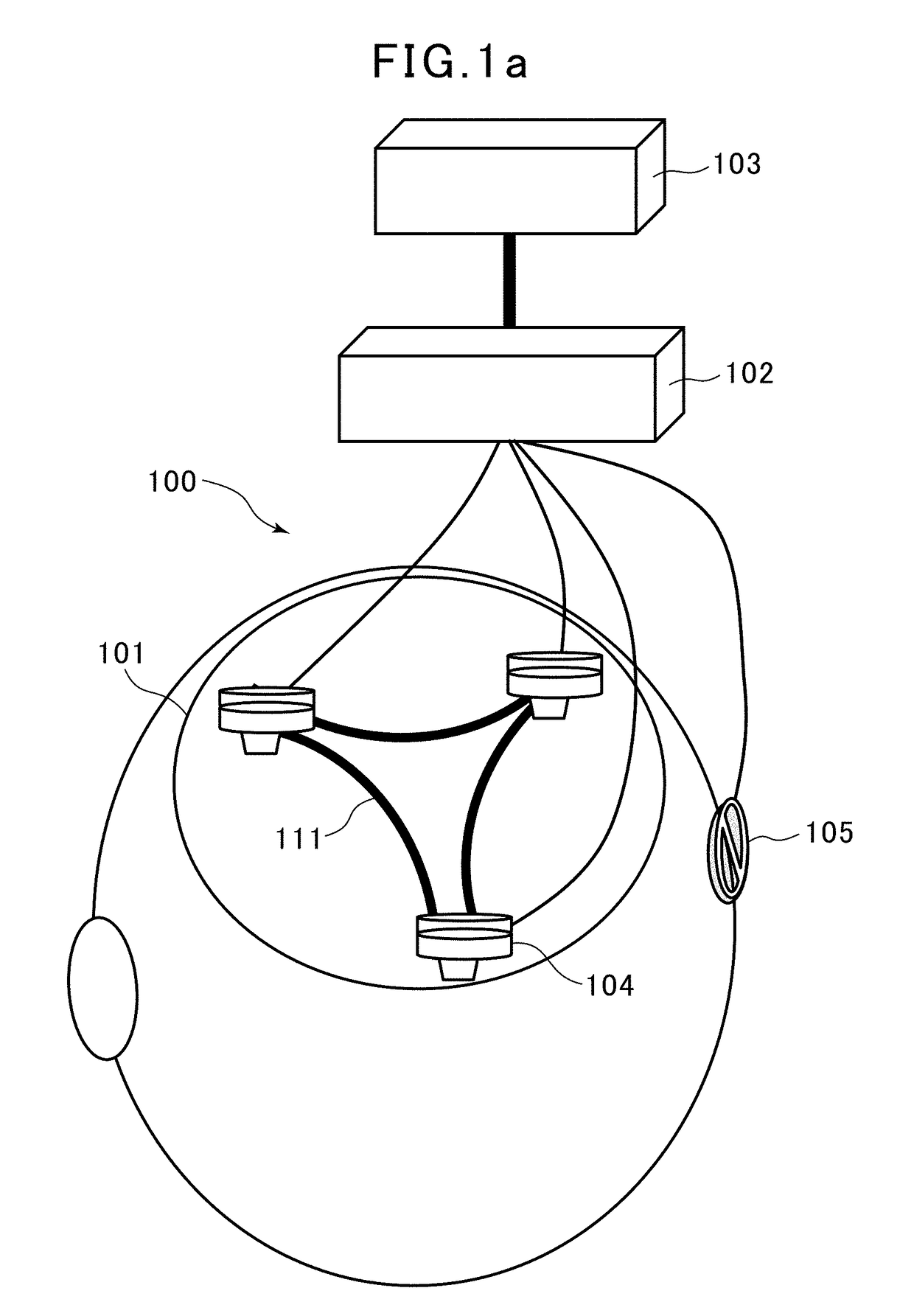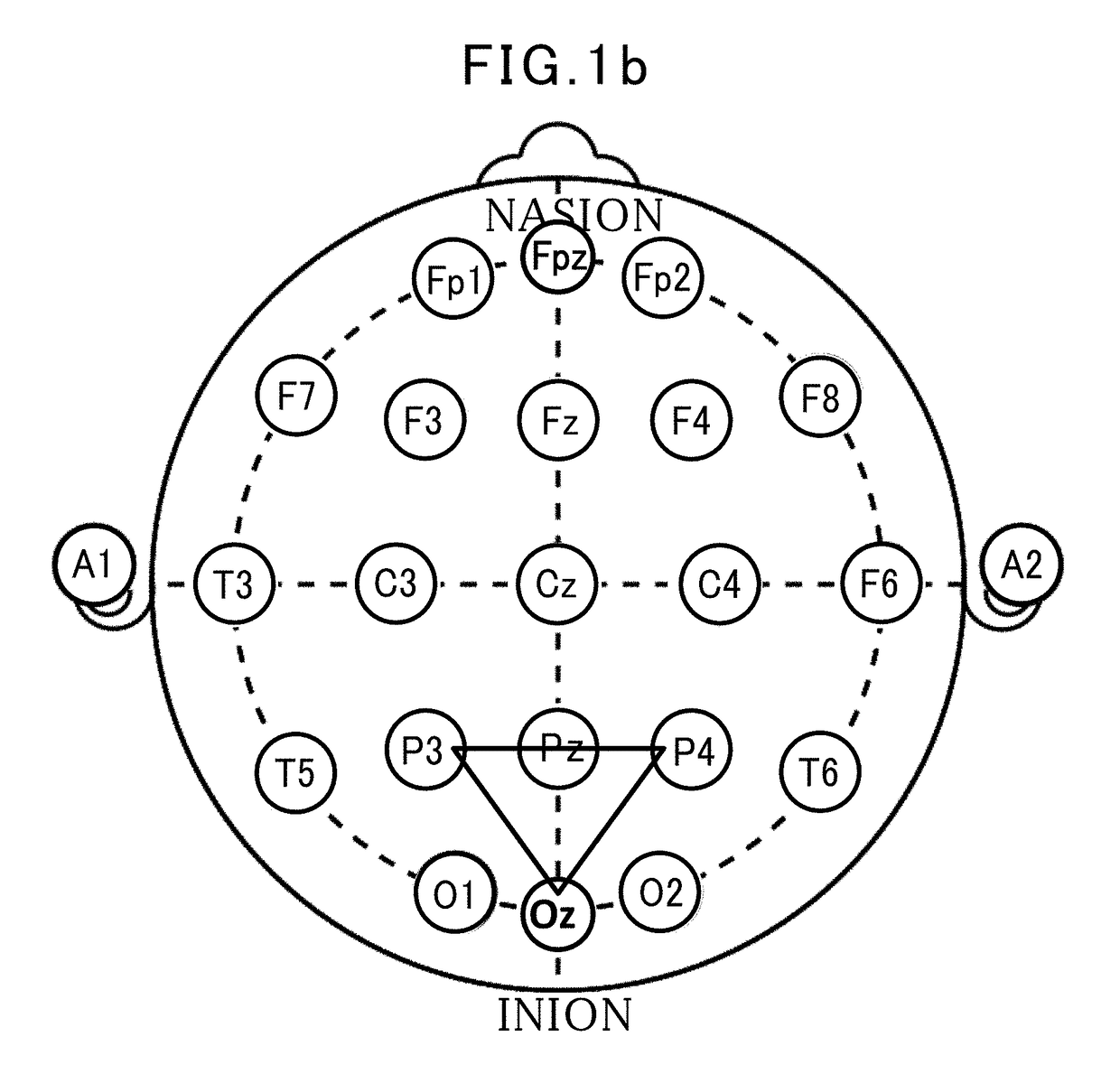Brain activity measurement device, program, and method
a brain activity and measurement device technology, applied in the field of brain activity measurement devices and programs, can solve the problems of increasing financial and psychological burdens on the entire society, the need for large-scale apparatuses, and the inability to use them, so as to reduce the amount of calculation, improve the accuracy, and improve the effect of brain function
- Summary
- Abstract
- Description
- Claims
- Application Information
AI Technical Summary
Benefits of technology
Problems solved by technology
Method used
Image
Examples
example 1
[0067]In Example 1, calculation of a triple correlation value for quantitatively evaluating deterioration in brain function due to dementia will be described.
[0068]As depicted in FIG. 5, three electrodes EA 501A, EB 502, EC 503 are arranged, respectively, at apexes of a triangle, to measure potential signals of VA(t), VB(t), VC(t) as differences between respective ones of the potentials of the electrodes and a potential of a reference electrode disposed separately. Preferably, the electrodes are arranged at positions P3, P4 and Oz, as mentioned above. The potential signals are processed by a triple correlation evaluation unit for deep-brain potential signals. FIG. 6 is a diagram depicting a processing block of a triple correlation evaluation unit 600. For example, this unit is realized by a 3-channel amplifier-bandpass filter and an analytical PC. As depicted in FIG. 6, from three signals amplified by a brain potential amplifier 601, deep-brain potential waveforms each having a spec...
example 2
[0076]In Example 2, the triple correlation values calculated in Example 1 are used to calculate an index for quantitatively evaluating deterioration in brain function due to dementia.
[0077]As described in Example 1, within the two delay time parameter space, data of the normal subject has a forest-like distribution in which tree-like protrusions are regularly arranged side-by-side. On the other hand, in data of the patient with Alzheimer's disease, a forest-like distribution has a large irregularity. In order to quantitatively represent this difference, the coordinate axes are rotated such that lines of trees become parallel to the τ1 axis and the τ2 axis, as depicted in FIG. 11a. FIG. 11a is an example of a normal subject, and is a top view of a three-dimensional presentation depicted in FIG. 10, wherein an area where three waveforms have the same sign is indicated by white, and an area where any one of the three signals has a different sign from those of the remaining signals is i...
example 3
[0083]In Example 3, the triple correlation values calculated in Example 1 are used to calculate an index for quantitatively evaluating deterioration in brain function due to dementia.
[0084]Triple correlation values of patients with Alzheimer's disease largely vary with respect to τ1 and τ2, as compared to normal subjects. Further, in terms of the triple correlation values per one second calculated by Formula 5 in Example 1, variation in the patients with the Alzheimer's disease is also larger than that in the normal subjects. Thus, a standard deviation in Formula 5 is defined as std_Si, and ten standard deviations (i=1, 2, . . . , 10) are calculate. Then, a standard deviation std_S of the ten standard deviations and an average value ave_S of the ten standard deviations are calculated, and a ratio of the standard deviation and the average value is defined as an index Ss.
std_Si=1N∑j=1N(Sij-S_i)2,S_i=1N∑j=1NSij(τ1-τ2)(Formula9)std_S=110∑i=110(Si-std_Si_)2,std_Si_=110∑i=110std_Si(Formul...
PUM
 Login to View More
Login to View More Abstract
Description
Claims
Application Information
 Login to View More
Login to View More - R&D
- Intellectual Property
- Life Sciences
- Materials
- Tech Scout
- Unparalleled Data Quality
- Higher Quality Content
- 60% Fewer Hallucinations
Browse by: Latest US Patents, China's latest patents, Technical Efficacy Thesaurus, Application Domain, Technology Topic, Popular Technical Reports.
© 2025 PatSnap. All rights reserved.Legal|Privacy policy|Modern Slavery Act Transparency Statement|Sitemap|About US| Contact US: help@patsnap.com



